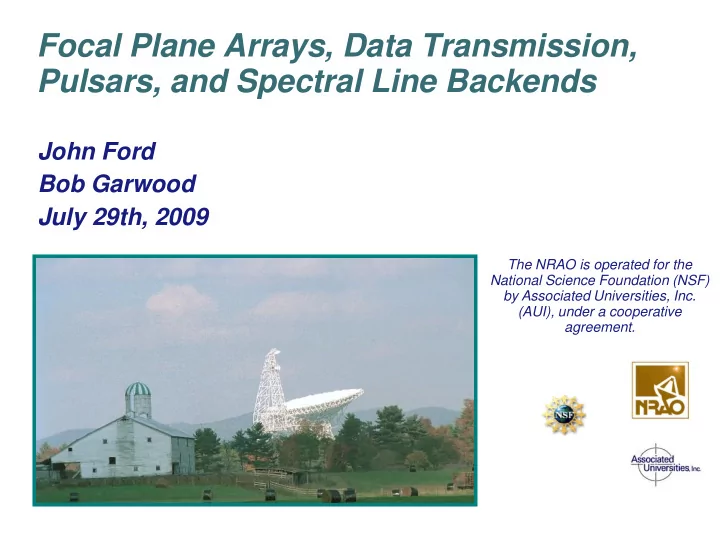

Focal Plane Arrays, Data Transmission, Pulsars, and Spectral Line Backends John Ford Bob Garwood July 29th, 2009 The NRAO is operated for the National Science Foundation (NSF) by Associated Universities, Inc. (AUI), under a cooperative agreement. GBT PTCS Conceptual Design Review April 8/9, 2003 Green Bank
GBT Design • 100 x 110 m section of a parent parabola 208 m in diameter • Cantilevered feed arm is at focus of the parent parabola 2
GBT Structure • Welded, Optimized Structure • Homologous design • Active surface 3
Active surface performance at 20 GHz 4
Receivers • Gregorian Focus – High frequency – Rotary Turret • Prime Focus – Low frequency – 300 MHz to 1200 MHz 5
GBT Turret Top 6
Q-band Receiver 7
Raw Data Transmission Bit Rates Data # links # links Bits / BW, Rate, @ 10 100 Equiv. Data Rate, GB/S IF's Pols samp GHz Gb/S Gb/S Gb/S EVLA's 800 100 1 4 8 6400 640 64 2.47 1600 100 2 4 8 12800 1280 128 4.94 1600 100 1 8 8 12800 1280 128 4.94 3200 100 2 8 8 25600 2560 256 9.88 400 100 1 2 8 3200 320 32 1.23 800 100 2 2 8 6400 640 64 2.47 112 7 2 4 8 896 89.6 8.96 0.35 28 7 2 4 2 224 22.4 2.24 0.09 8
Spectrometers • Output data rate is proportional to: – # spectral channels – # IF's – # switching signal bins – # bits of precision kept – Inversely proportional to accumulation time 9
Output Date Rate Examples Total Cross Equiv GBT Output Data Rate, Channel Terms Spectro- GB/S IF's Pols Bits s/ IF Bins Tint ? meters 1.31 100 2 32 16384 1 0.01 0 156.25 2.62 100 2 32 16384 2 0.01 0 312.5 5.24 100 2 32 16384 4 0.01 0 625 2.62 100 2 32 16384 1 0.01 1 312.5 5.24 100 2 32 16384 2 0.01 1 625 10.49 100 2 32 16384 4 0.01 1 1250 Existing GBT Spectrometer Data Rate 0.000262 8 1 32 2048 4 1 0 800 MHz 0.008389 16 1 32 16384 4 1 1 50 MHz 10
Pulsars • Pulsar Search – Up to 200 MB/s data rate – Raw time series spectra recorded – Search is done off-line • Parameter search over DM, period. • Acceleration searches for binary pulsars • ~2 days to search 2 minutes of data on one core – Requires lots of storage for the data. • Pulsar Timing – Coherent dedispersion for best timing residuals – Requires real-time fast convolution over ~128 channels at 1.6 GS/s. – Almost 100% data reduction. Output data is folded and combined. – Using GPU's to run the fast convolutions 11
Spectral line pipeline • Pleasingly parallel for most steps – data from each sampler(beam/feed/polarization) is treated independently. So long as one processor can keep up with the data from one sampler, just buy enough processors to keep up with the data rate. Divide and conquer. • Except when it isn't – Statistical flagging might involve comparisons between multiple samplers. – The same (or nearly the same) region on the sky will often be sampled by more than one sampler. That should be used to improve the relative calibration of all of the samplers (multi- feed equivalent to basketweaving). • The sooner you can reduce the data volume, the easier it is to keep up with the data rates. It’s important in each science use case to make it clear when it’s OK to smooth, average, etc to reduce the data volume. 12
Data archiving • What gets archived? How do we tell what’s good data and what can be tossed – (data quality measures)? How far down the pipeline can the data be automatically – processed before you need to archive it (how much data reduction can be done)? – Keep raw data local for some period, archive for the long term some processed data (at perhaps several steps in the pipeline). How long would the raw data need to be kept around (size of local archive)? 13
Recommend
More recommend